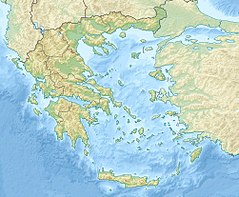Rio–Antirrio bridge
| Rio–Antirrio Bridge Γέφυρα Ρίου - Αντιρρίου |
|
|---|---|

The bridge on a windy day
|
|
| Carries | 6 lanes of Ionia Odos, (2 lanes each way & 2 emergency lanes) & 1 pedestrian & bicycle lane, European route E65 |
| Crosses | Gulf of Corinth |
| Locale |
|
| Official name | Charilaos Trikoupis Bridge |
| Owner | Greek State |
| Maintained by | Gefyra SA |
| Characteristics | |
| Design | Cable-stayed bridge by Berdj Mikaelian |
| Total length | 2,880 meters (9,450 ft) |
| Width | 27.2 meters (89 ft) |
| Longest span | 560 meters (1,840 ft) |
| History | |
| Opened | 7 August 2004 |
| Statistics | |
| Daily traffic | Expected: 11,000 vehicles/day |
| Toll | Cars: 13.20 € Motorcycles: 1.90 € Coaches: 29.70–64.00 € Trucks: 19.90–41.00 € |
The Rio–Antirrio Bridge (Greek: Γέφυρα Ρίου-Αντιρρίου), officially the Charilaos Trikoupis Bridge, is one of the world's longest multi-span cable-stayed bridges and longest of the fully suspended type. It crosses the Gulf of Corinth near Patras, linking the town of Rio on the Peloponnese peninsula to Antirrio on mainland Greece by road.
The 2,880-metre-long (9,449 ft) bridge (approximately 1.8 miles) dramatically improves access to and from the Peloponnese, which could previously be reached only by ferry or via the isthmus of Corinth in the east. Its width is 28 m (92 ft) — it has two vehicle lanes per direction, an emergency lane and a pedestrian walkway. Its five-span four-pylon cable-stayed portion of length 2,252 m (7,388 ft) is the world's second longest cable-stayed deck; only the deck of the Millau Viaduct in southern France is longer at 2,460 m (8,071 ft). However, as the latter is also supported by bearings at the pylons apart from cable stays, the Rio–Antirrio Bridge deck might be considered the longest cable-stayed "suspended" deck.
This bridge is widely considered to be an engineering masterpiece, owing to several solutions applied to span the difficult site. These difficulties include deep water, insecure materials for foundations, seismic activity, the probability of tsunamis, and the expansion of the Gulf of Corinth due to plate tectonics.
Charilaos Trikoupis was a 19th-century prime minister of Greece who suggested building a bridge in the current location but the wealth of Greece at the time didn't permit its construction.
The bridge was planned in the mid-1990s and was built by a French-Greek consortium led by the French group Vinci SA which includes the Greek companies Hellenic Technodomiki-TEV, J&P-Avax, Athena, Proodeftiki and Pantechniki. The consortium operates the bridge under concession under its ΓΕΦΥΡΑ or ΓαλλοΕλληνικός Φορέας Υπερθαλάσσιας ζεύξης Ρίου- Αντιρίου (GEFYRA, Greek for "bridge", French-Greek Carrier of Oversea Connection of Rio–Antirrio) subsidiary. The lead architect was Berdj Mikaelian. Site preparation and dredging began in July 1998, and construction of the massive supporting pylons in 2000. With these complete in 2003, work began on the traffic decks with the steel fabrication being carried out by Cleveland Bridge U.K. and supporting cables by Freyssinet. On 21 May 2004 the main construction was completed; only equipment (sidewalks, railings, etc.) and waterproofing remained to be installed.
...
Wikipedia

